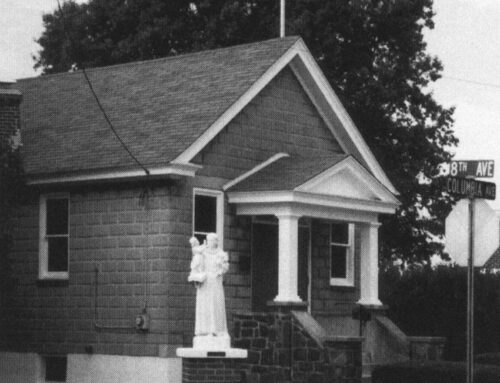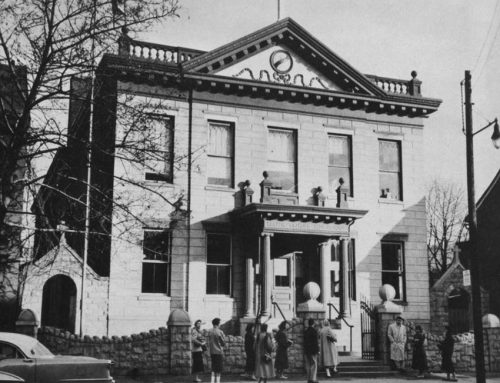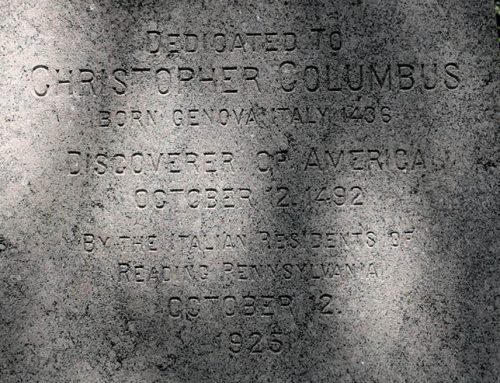The first Catholic congregation to be established in Pennsylvania was in 1734 when Father Greaton, S. J., a missionary from Maryland, built the Church of St. Joseph in Willing’s Alley in Philadelphia. In 1741 Father Theodore Schneider was sent by the German Province of Jesuits to minister to the Germans in Pennsylvania. Father Schneider, who had been an outstanding professor at Heidelberg University, Germany, began teaching the children of Berks County at Goshenhoppen, now Bally. In 1743 he founded the Church of the Most Blessed Sacrament.
The parish of the Most Blessed Sacrament (MBS) in the Borough of Bally, Berks County, Pennsylvania began as an important Catholic mission known as the Mission of St. Paul. It was commonly referred to as the Goshenhoppen Mission because of its location within the Goshenhoppen region, the upper region of the Perkiomen Valley. Goshenhoppen is an American Indian name generally thought to mean meeting place. Bally is situated in eastern Berks County near the Montgomery County line. The borough is located on the “Reading Prong,” under which a two million year old uranium deposit runs from just outside Reading to Easton and into New Jersey.
As indicated on the tombstone of the founder of the Goshenhoppen mission, there was missionary activity in the Goshenhoppen area as early as 1716. Jesuit Missionaries from the Old Bohemia mission center in Cecil County Maryland first ministered to the few scattered Catholics in Pennsylvania. By 1719 Father Joseph Greaton, an English Jesuit arrived at Old Bohemia and immediately began work in the Pennsylvania mission. By 1729 he established a residence in Philadelphia and in 1733 began to build St. Joseph’s church there, the first Catholic Church in Pennsylvania. While English law at the time prohibited the building of a Catholic Church, the Governor of Pennsylvania upheld the legality of the church based on William Penn’s charter and his policy of religious tolerance. Even with his new church in Philadelphia, Father Greaton continued to travel throughout Pennsylvania to minister to the small Catholic population.
With the growth of the German Catholic population of Pennsylvania, two German Jesuits, William Wappeler and Theodore Schneider arrived in America in early June 1741 to assist Father Greaton by specifically ministering to the scattered German Catholics of Pennsylvania.
Father Wappeler’s mission territory was west of the Schuylkill River and he established his mission center at Lancaster and later at Conewago. Father Schneider’s mission territory was east of the Schuylkill River and he initially centered his mission with Father Greaton at St. Joseph’s church and traveled throughout the area learning the location of Catholic families. Each of the mission territories was dedicated to a patron Saint. Father Schneider’s mission was the mission of St. Paul. By 1743 he established a residence in Goshenhoppen, more centrally located within his mission territory. From their mission centers the two German Jesuit missionaries traveled extensively ministering to the Catholics scattered throughout Pennsylvania, Maryland and New Jersey. In 1748, after 7 years of strenuous work in his mission field, Father Wappeler returned to Germany in poor health leaving his mission as well as the Goshenhoppen mission in the hands of Father Schneider. It was not until 1752 that permanent help was finally available for Father Schneider. He could then focus his attention on the development of both his large mission territory and his plantation at Goshenhoppen.
Below: Most Blessed Sacrament Church circa 1885 from a drawing published in the “The Catholic Church in Colonial Days” by John Gilmary Shea. While many of the details of the church have changed, the basic church of today closely resembles the church in the drawing. The church built in 1754 by Father Theodore Schneider SJ appears on the right. The major addition built in 1835 by Father Boniface Corvin SJ is on the left.

The Goshenhoppen Mission
When the Beidler land became available to Father Schneider and whether he built on the land now in his possession as tradition suggests or used the existing buildings on the former Beidler homestead is currently under investigation. Ulrich Beidler left the Goshenhoppen area for the newly available lands west of the Susquehanna with several other neighboring Mennonite families including the families of his brothers Christian and Peter, and the families of Michael Schwarz and Jacob Fluery. The westward migration of these families began in 1743 and Ulrich Beidler purchased his land in what would become York County in 1744.
Below: The title Page of Father Schneider’s sacramental register. Note that “Cushenhopen” appears second after Philadelphia in his abbreviated list of mission locations.

On October 5, 1748 Father Greaton acquired the warrant on a 110-acre 100-perch woodland lot from the proprietors. The lot was separate from the Beidler tract and had been previously warranted to Jost Herbough whose warrant was vacated.
In a 1749/50 letter Father Schneider wrote: “At the moment I am considering building, in addition to a new church, a new dwelling on the farm…” He acknowledged that he did not have the necessary funds to start the project but hoped he could obtain them through the generosity of European benefactors.The use of the word “new” and the early reference to a “priest house“ in his register suggests the existence of a place of worship and residence at the time this letter was written.
On August 3, 1752 Father Greaton acquired the patent for the property on which the current church is built. This was a 213-acre tract originally warranted to the same Ulrich Beidler, which, along with the warrant on an additional 50-acre Beidler tract were vacated and became available to the Jesuits through Penn’s proprietary land agents. The Goshenhoppen Mission now consisted of 385 acres of farmland, all contiguous, and 110 acres of woodland separate from the farmland.
Father Schneider’s Church
Father Schneider’s new church was completed in the summer of 1754. On May 1, 1755, the Rev. William Smith, Anglican minister and Provost of the College of Philadelphia wrote to Thomas Penn about the area Catholics, “Last summer they have finished as large and elegant church as any in the Province for public worship about 35 miles from town and by all account their numbers increase greatly.” While not specifically identified, there is little doubt that this reference is to Father Schneider’s new church in Goshenhoppen, which is about 35 miles from Philadelphia and the only other Catholic Church in the area in addition to St. Joseph’s.
The local tradition of cooperation between area religious groups includes the tradition that the Mennonites helped Father Schneider build his new church. In appreciation for their help Father Schneider returned ownership of the land on which the Mennonite meeting house was built. On April 11, 1755 Father Robert Harding (Father Greaton’s successor) sold one acre and nine perches of the 121-acre Ulrich Beidler tract to George Bechtel, Mennonite Minister, for the sum of £2 and 10 shillings. Bechtel then transferred the land to the Mennonite congregation, and shortly thereafter the old meetinghouse was torn down and a new larger one built in its place. Tradition also indicates that the Catholics helped the Mennonites build their new meetinghouse.
Goshenhoppen Mission Circuit
Although area Catholics traveled great distances to attend Father Schneider’s church, it was still necessary for him to continue his mission travels. In August 1758 he received additional help in his mission when Father Ferdinand Steinmeyer (alias Father Ferdinand Farmer) was transferred from the Lancaster mission to St. Joseph’s Church in Philadelphia and assumed Father Schneider’s mission duties in the Philadelphia area and in New Jersey. However, Father Schneider’s mission territory still remained very extensive covering the present day counties of Berks, Bucks, Lehigh, Montgomery, Schuylkill, and Northumberland.
Father Schneider’s sacramental registers as well as those of his successor’s chronicle their mission travels throughout Pennsylvania and New Jersey during the significant mission period from 1741 to 1819. Published under the title of “The Goshenhoppen Registers”, they cover the pastorates of Father Schneider 1743-1764, Father John Baptist De Ritter 1765-1787, Father Peter Helbron 1787-1791, Father Nicholas Delvaux 1791-1793 and Father Paul Erntzen 1793–1818. All but Fathers Helbron and Delvaux ended their mission careers in service to the Goshenhoppen Mission and are buried under the altar of the church built by Father Schneider.
On the mission circuit, specific meeting places and meeting times were established as well as mechanisms to notify area Catholics of the arrival of the missionary priests. Initially they met in the homes of Catholic families. As the population growth in an area increased, small churches were built as gathering places.
Many of the Catholic population centers developed near early industrial sites such as iron forges and glass works or major building projects like canals and railroads. Project completions and changes in economic conditions periodically resulted in Catholic population shifts. These population shifts resulted in the growth of some churches and the closing of others.
The suppression of the Jesuit Society between 1773 and its restoration in 1814 and the Revolutionary War resulted in periods of times when few priests were available to minister to the Pennsylvania Catholics. Often times when a church would close or in a period without the regular services of a missionary priest, Catholics sought the services of the nearest ministers for ongoing spiritual guidance. The surnames of families found previously in Catholic records can then be found in the records of other area churches or the records of traveling ministers of other faiths.
However, when additional priests became available and permanently assigned to the areas of growing Catholic populations, parishes were formed and staffed by resident pastors. Those pastors in turn traveled through the outlying areas of their territory reducing the overall responsibility of the Goshenhoppen Mission and its importance as a mission center.
Most Blessed Sacrament Parish
While the Jesuits retained ownership of the Goshenhoppen Mission during the period that their order was suppressed, they did not actively manage it until after the Jesuit order was fully restored. Father Paul Kohlman became pastor in 1819 after the death of Father Paul Erntzen who had been pastor for 25 years. He was the first Jesuit pastor assigned after the suppression and was faced with the task of reviving the mission, which had fallen into a considerable state of decay. Father Kohlman’s health restricted his ability to travel and resulted in his establishing a regular schedule of services at the church. This began the development of the church as a local parish. In 1822 Father Boniface Krukowski was assigned to the mission to assist Father Kohlman in the restoration of the mission and to travel the now greatly reduced mission circuit. Known as Father Boniface Corvin, he became pastor in 1824.
In 1826, Father Corvin completed the restoration of the mission complex with major renovations and improvements to Father Schneider’s church and mission house. Through the guidance of Father Corvin, the parish grew and in 1833 a decision was made to enlarge the church with construction to begin the following year. On May 18, 1834 the cornerstone was laid for the new church addition and on October 11, 1835 the expanded church was dedicated as the Church of the Most Blessed Sacrament. Exactly two years after its dedication, on October 11, 1837, Father Corvin died while visiting his Jesuit brothers in Philadelphia. On October 31, 1837 Father Augustine Bally became pastor and finished the interior decorations of the church according to the plans of Father Corvin.
Father Bally continued the Jesuit traditions of a strong education system established by the early schools of Father Schneider. In 1856 he built a new parish school called St. Aloysius Academy. With the introduction of the public school system he operated the school under an unusual arrangement with the county superintendent of schools. The parish provided the building and elementary school teacher and the county paid for the teacher of the upper grades, selected by Father Bally.
During the pastorate of Father Bally, the Jesuits began selling off the plantation lands in small lots to raise money for the support of Jesuit colleges, (St. Joseph’s in Philadelphia and Georgetown in Washington DC). The land sales increased the size of the parish by attracting Catholics from outlying areas and further reduced the size of the mission circuit that Father Bally continued to travel. The resultant population center on former mission land became known as Churchville.
After a long and distinguished career as pastor of MBS, Father Bally died on January 30, 1882 and was granted his wish to be buried with his beloved parishioners. His grave is in the center of the new parish cemetery. After his death authorities were petitioned to establish a post office in Churchville. Their request was granted and the Post Office was named the Bally Post Office.
Father John Meurer, Father Bally’s assistant was named the new pastor. He would be the last of the Jesuit pastors as in 1887, the Jesuits sold the mission farm to John Brogley and the only remaining mission land was that occupied by the church, rectory, school, convent and cemetery that is today the MBS Parish center. On November 15, 1888 the Jesuits turned the parish over to the Diocese of Philadelphia and it has been staffed and operated as a diocesan parish ever since.
Under first Philadelphia and later Allentown Diocesan leadership the parish buildings were upgraded and decorated while still preserving much of the history of the church. The former sanctuary of Father Schneider’s church is preserved as a chapel behind the sacristy. The organ in use in the church today is the historic Krauss Organ originally installed in 1799. The primary decorations of the church include the artwork of Berthold Imhoff and the stained Glass windows of J. M. Kase (nave) and Frans Nicolas of Roermond, Holland (sanctuary). The Last Supper painting now hanging in the sanctuary was a 1764 gift to Father Schneider from Karl Theodore, Prince Elector of the Palatinate. It had been the altar painting in the church from 1764 – 1890 when the current altar painting of the Crucifixion was acquired. After a recent restoration, the Last Supper painting was returned to the sanctuary for all to admire. The paintings of the Stations of the Cross, reproductions of Joseph Führich’s famous Vienna masterpiece, have also been restored in recent years.
Monsignor Charles Allwein administrator at MBS from 1930 to 1931 and pastor from 1952 to 1972 assembled a significant collection of memorabilia on the history of the mission and parish. He organized the collection of books and artifacts into a museum and library housed in the former mission house built by Father Schneider. The library is available for research through arrangement with the parish office. Initially dedicated in memory of Father Bally, the museum was rededicated in honor of Monsignor Allwein in 1991 as part of the parish 250th Anniversary celebration. Monsignor Allwein, author of the published history of MBS, died on February 4, 1995. The details of the history of the Goshenhoppen mission continue to unfold through the ongoing research of the Museum Committee at MBS. Numerous documents and studies have been added to the collection in recent years. Through this effort many of the early traditions have been confirmed, some historical accounts corrected and other avenues of research opened with newly discovered information.






Leave A Comment